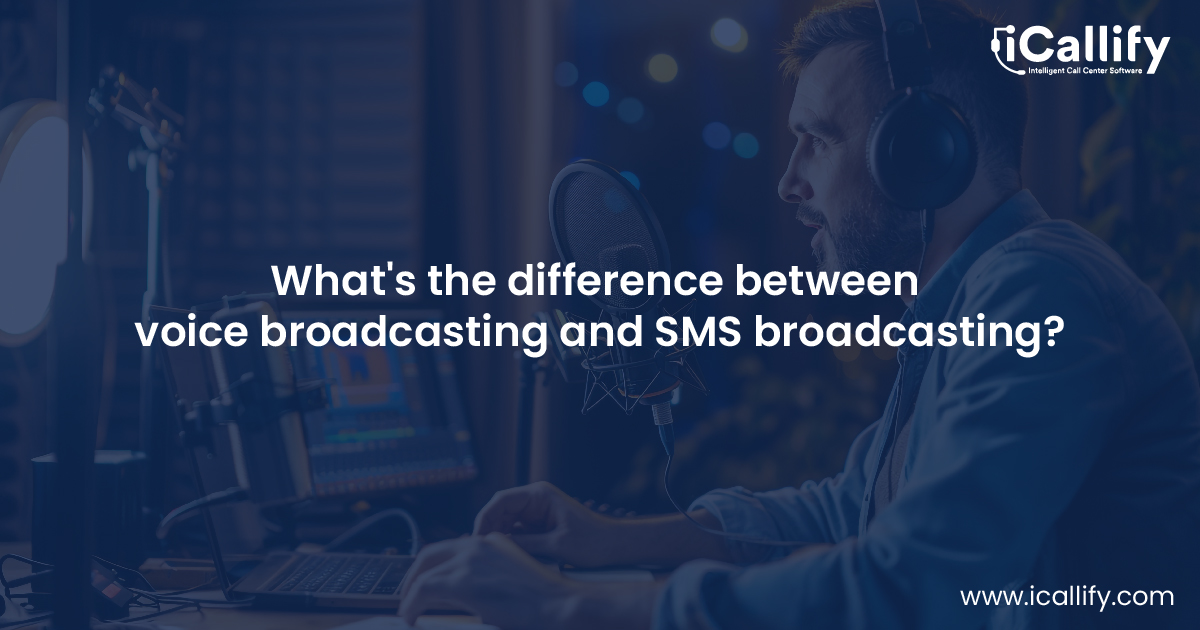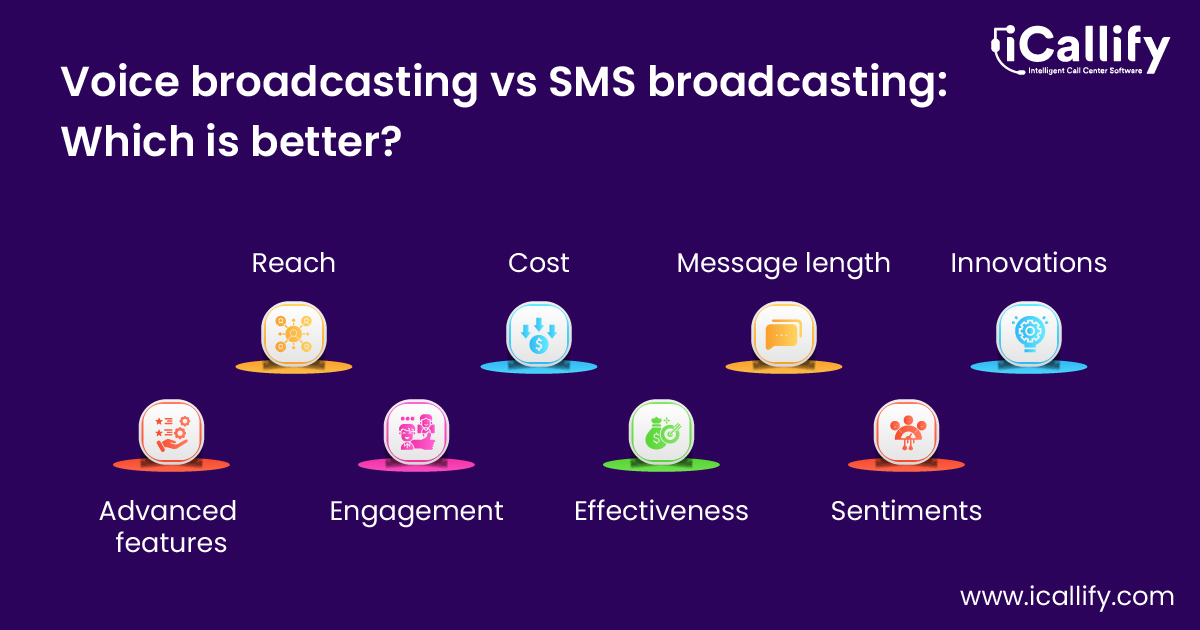
In business communication, broadcasting stands as a cornerstone. Certainly, it offers a streamlined approach for companies and organizations to conduct massive campaigns efficiently and cost-effectively. The surge in popularity of broadcasting solutions attests to their efficacy. There are different types of broadcasting tools and models available. However, engagement takes over the whole game. Therefore, SMS and voice broadcasting software solutions are highly popular across industries.
While social media broadcasting systems are on the rise with the growing prominence of social networking platforms, their usage comes with certain restrictions. Moreover, email broadcasting is also prominent in some cases. However, the open rate and engagement rate are often disappointing for several companies. Consequently, voice and SMS remain two potent and versatile mediums for effective broadcasting. Therefore, these two broadcasting mediums are racing against each other for dominance and value.
In this blog post, we will delve deeper to unveil the real winner between both broadcasting mediums.
So, let’s get started to discover the right and most engaging mode of broadcasting for your business.
1. What is broadcasting?
It is a way of sending a predefined message to a selected group of contacts via any specific mode of communication. The whole process is automated and does not require any human intervention once the campaign is executed using the right broadcasting solution.
Depending on the media type, there are different types of broadcasting available in the market such as:
- Voice broadcasting
- SMS broadcasting
- Email broadcasting
- Social media broadcasting
- Fax broadcasting
Boost customer engagement with our customized voice and SMS broadcasting solutions.
2. What is voice broadcasting?
It is a method of sending a voice message to many recipients at the same time. It enables automatic delivery of voice messages to customers, employees, or contacts without the need for manual dialing or individual interaction in the form of an incoming phone call. Therefore, it is also referred to as call broadcasting. Audio broadcasting is another name for this mode of broadcasting.
Traditionally, the voice messages were prerecorded files that users uploaded to the voice broadcasting software open source solution. However, technological advancements have shown progress in this feature, too. The modern solutions use Natural Language Processing (NLP) along with Text to Speech (TTS) converter to convert a written text message into a voice message.
Recommended Reading, Voice Broadcasting Software: Redefining the Future of Mass Communication.
Defining a voice broadcasting solution
Voice broadcasting systems is a software solution that lets businesses and enterprises create and execute call broadcasting campaigns. Certainly, it comes with a range of features to manage contact, voice messages, and broadcasting campaigns. Moreover, it provides advanced features like multiple retries, campaign scheduling, TTS, reports, and more. The audio broadcasting campaign executed using this system will send an incoming call to the selected list of contacts. On answering the call, they will listen to the prerecorded voice message.
3. What is SMS broadcasting?
Like voice broadcasting, it is a way to send a text message or SMS to a predefined group of contacts. It also uses a software solution to execute the broadcasting campaign. Moreover, this solution also does not need any human intervention once the campaigns are blasted.
Defining SMS broadcasting solution
Similar to voice broadcast dialer software, SMS broadcasting software also provides a GUI tool to create a campaign to send SMS to a predefined group of people. The message will be delivered to the SMS app of the phone of the user. Typically, on the first attempt only the message gets delivered. Therefore, it does not require multiple retries. The SMS broadcasting tools also provide access to different features like campaign scheduling, reporting, and more.
4. Voice broadcasting vs. SMS broadcasting: The Real Battle

Often, voice and SMS broadcasting are perceived as interchangeable methods with minimal distinctions. However, nuanced differences exist between the two, and their effectiveness can vary depending on the campaign’s objectives and several other metrics. While certain campaigns may benefit from utilizing both methods, others may find one approach more effective than the other. Therefore, gaining a comprehensive understanding of both methods is essential for informed decision making in campaign strategies.
To give you the required details for brainstorming and decision-making, we will compare different metrics to find the clear winner between both popular broadcasting means.
4.1 Advanced features
This is purely related to the software that you use to run a campaign. Unquestionably, a voice broadcasting solution provides way more features than an SMS broadcasting solution. SMS are plain text messages. However, voice messages have several elements that can make them more artistic and appealing. Therefore, the solutions available to broadcast voice messages have a much wider range of features than their counterparts. Therefore, voice broadcasting systems win this comparison metric.
4.2 Reach
Undoubtedly, this is one of the foremost metrics to compare. The reach of the message defines how many users the message has reached. Generally, a voice message is delivered as a phone call. Conversely, an SMS is delivered as a short message. Both of these message types need an active phone connection. Unlike several other VoIP apps or broadcasting types, they don’t need an active or high bandwidth internet connection. Therefore, the reach of the message is often equal in general terms. However, if we dig a little deeper, then some other driving factors can affect the results.
Fundamentally, voice messages are circulated as phone calls. Therefore, a person must attend the call. Undoubtedly, a voice broadcasting software solution will attempt multiple times to reach a customer or prospect. However, there is a condition that the person attends the call.
Conversely, the reach of a text message is not dependent on any intervention from the recipient. In other words, the SMS will be delivered if the phone and its network are on.
Therefore, in general cases, SMS wins the game here because it will reach a wider audience.
4.3 Engagement
Certainly, engagement rate is an even better metric to focus on because just reaching a client or prospect is not enough. Undoubtedly, it is necessary to engage them, so they get the essence of the message.
A voice message is delivered as a phone call. Therefore, it is more likely that the target audience will attend the call and listen to the voice message. On the other hand, an SMS can stay unread, without engaging the user for days or years and even get deleted without getting read. Therefore, in general cases, if a voice message reaches the client, it is more likely to engage them. However, even if SMS reaches 100% of the target audience, it is not guaranteed to receive the expected engagement rate. As a result, we can conclude that voice blasting has more engagement than SMS broadcasting.
4.4 Cost
The cost is one of the driving factors for businesses. In the case of the broadcasting solution, there are two types of costs. Therefore, we will talk about both of them briefly.
Software cost
Definitely, there is a one-time or recurring cost of using SMS and/or voice broadcast dialer software to execute broadcasting campaigns. Again, this cost may vary depending on various driving factors. For example, required features, supported integrations, country, white labeling, and many other driving elements can increase or reduce the cost of broadcasting software. Therefore, you cannot judge the effectiveness of text message or call broadcasting with the cost of the software.
Undoubtedly, the value production makes more difference. Multiple factors define the value of the software. Therefore, you should keep the cost of the software as an exception while comparing these two broadcasting tools. Still, if you need a clear indicator then a major voice broadcasting tool is more expensive than the SMS blasting solution.
Message cost
Conversely, there is an added expense associated with voice and SMS broadcasting. Voice call tariffs are often high. However, VoIP based communication often reduces the cost per phone call. However, several driving factors can increase the overall cost of the campaign such as the length of the call to play the voice message, selected routing strategy, destination (local or international), and more.
Conversely, SMS is short. Moreover, tariffs for bulk messaging are quite cheap. Additionally, for SMS blasting, you may also receive special discounted rates from the provider. Therefore, SMS is cheaper compared to voice blasting.
Explore the broadcasting methods that can revolutionize your communication strategies.
4.4 Effectiveness
Certainly, this is one of the most appealing and vital metrics to monitor while comparing. If you are reaching the target audience and engaging them, still your message is not effective enough, and then you are less likely to reap any advantages. Therefore, you must measure the effectiveness of campaigns.
Generally, there are several driving factors that can have an impact on your broadcasting campaigns. The major ones are listed hereunder:
- Length of the message
- Appeal in the message with creativity or empathy
- Audience preference
- Need of the audience
- Right time to reach the audience And more
All these metrics are dynamic and may reap different values for SMS and voice broadcasting campaigns. For example, in countries like India, people attend calls more often and rarely read SMS. On the other hand, in countries like the USA, more than 70% of people read an SMS within the first three minutes. Likewise, some people may attend calls during off-hours and some people ignore reading SMS during off-hours. Likewise, some people like shorter messages. Conversely, some people find appealing messages more interesting even if they are lengthy.
In short, there is no clear winner here because it is highly dependent on other criteria that are directly related to the target audience.
4.5 Message length
This is another dynamic metric to measure the effectiveness of your campaign.
Voice blasting supports longer messages that are much more expressive than a short message that is concise and to the point. On the other hand, voice messages can also add a preface, message, and call to action. However, SMS is short and must focus on conveying the crux of the message.
The abovementioned brief may give voice broadcasting as a winner but wait. This metric is also dependent on the type of message you want to convey.
If you want to convey a long or complex message, then voice broadcasting is better. However, if you just want to give an alert or update, then SMS blasting is the winner.
4.6 Sentiments
When you run a voice broadcasting campaign using a voice broadcasting software open source solution, you can actually use different expressions and sentiments to engage clients seamlessly. In fact, you can create an immersive effect with a change of pace, voice modulation, and the use of other emotions in the voice message at the right time.
SMS is often pretty plain. In fact, the traditional apps do not even support emoticons. Therefore, they are less intriguing than voice broadcasting campaigns. Therefore, call broadcasting wins the game here.
4.7 Innovations
Innovation is the key to success. Certainly, you have read this proverb, and it indicates that innovations will provide other ways to reach clients and engage them. Moreover, you can encourage them to take your preferred actions.
As voice broadcasting has several shades, utilities, and heavy usage, companies are heavily investing in improving this technology and adding more interesting features to the software. Moreover, voice messages are more flexible than SMS. Therefore, there is a scope for innovation that can let technologies like AI and ML pave their way into broadcasting solutions for calls. However, SMS is still straightforward. They are short. They are plain. Even if some latest SMS apps support emoticons, but still there is a limited scope of innovation. Therefore, voice broadcasting has the upper hand here.
5. Concluding notes
In conclusion, both SMS and voice broadcasting are engaging, appealing, and beneficial. Moreover, there are different criteria that can make one winner over the other. Therefore, it is always necessary to compare all different aspects to choose the right strategy and tool for your next broadcasting campaign.
If you are willing to invest in technology, you can acquire both solutions to run your business more efficiently and reap better returns.
We offer both SMS and voice broadcasting software solutions. To learn more about these solutions and book a free demo, contact us.





Leave a comment